HDMS Peder Skram was originally laid down as a wooden steam frigate for the Royal Danish Navy. but was converted to an armored frigate while under construction in the early 1860s. She had an uneventful career before she was stricken from the Navy List on 7 December 1885 and became accommodation ship until sold for BU 1897. She was the third Danish armoured ship after the conversion (vote at the same time) of Dannebrog, a former ships of the line, and the purchase of a monitor.
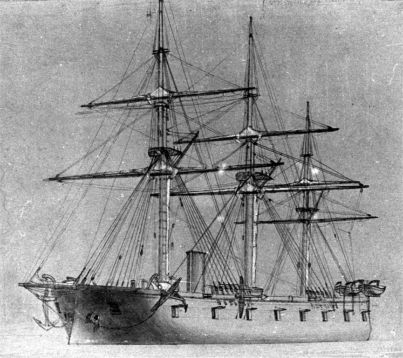
Development
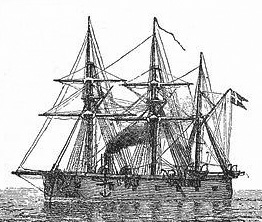 HDMS Dannebrog, seen here, was Danish navy’s last ship of the line and after nine years of service from 1853 to 1862 (she was laid down in 1849) she was rebuilt in the Orlogsværftet dock and converted as the first Danish armored Frigate, the first Ironclad. It needed the Battle of Hampton Roads in March 1862 to convince the Danish admiralty of the reality of this new trend. The parliament was more complicated to obtain though. Tests made of naval guns under armour plates in April-May 1862 and much pressure from the press, twisted arms of the Reichstag enough to buy a monitor, judged cheaper than a sea going ironclad. Next it was judged as much a cost-saving measure to to convert Dannebrog and the frigate Peder Skram into armored ships.
HDMS Dannebrog, seen here, was Danish navy’s last ship of the line and after nine years of service from 1853 to 1862 (she was laid down in 1849) she was rebuilt in the Orlogsværftet dock and converted as the first Danish armored Frigate, the first Ironclad. It needed the Battle of Hampton Roads in March 1862 to convince the Danish admiralty of the reality of this new trend. The parliament was more complicated to obtain though. Tests made of naval guns under armour plates in April-May 1862 and much pressure from the press, twisted arms of the Reichstag enough to buy a monitor, judged cheaper than a sea going ironclad. Next it was judged as much a cost-saving measure to to convert Dannebrog and the frigate Peder Skram into armored ships.
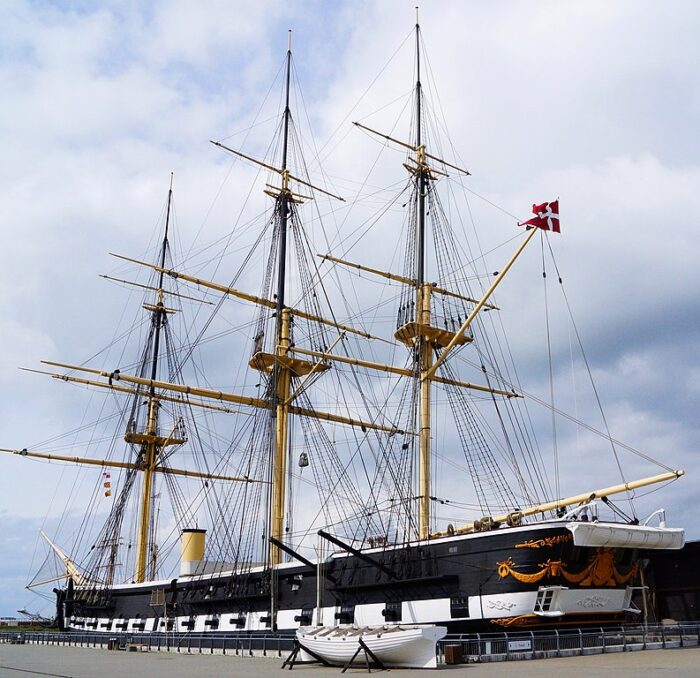
The Frigate Jylland, blueprint for the Peder Skram. She had been preserved. She was armed with twenty 6 inch/50 RML guns, six 5 inch/28 RML guns, six revolver cannons, one 37mm breechloading cannon and a Machine gun.
In Danish this vessels was called a “Panserfregatten”. She was originally started at Orlogsværftet on 19 May 1859 as a wooden steam screw propelled frigate and a larger version of the frigate Jylland, started two years earlier. Initially, the Orlogsværftet concentrated its efforts on completing the conversion of Dannebrog, and it was not until the summer of 1863 that conversion of Peder Skram resumed. Armor plates were delivered from England, then the structure and assembly parts was made by Baumgarten & Burmeister, which also delivered the steam engine. The latter was the most powerful ever installed on a Danish warship. The hull was designed so that there was a port aft to move guns from the broadside to the rear if needed. She was named after naval hero Admiral Peder Skram and her conversion was designed by Otto Fredrik Suenson, same as for Dannebrog.
Design of the class
Hull and general design
Peder Skram was 226 feet 3 inches (69 m) long between perpendiculars for a beam of 49 feet 6 inches (15.1 m) and draft of 21 feet 8 inches (6.6 m) for a displacement of 3,373 long tons (3,427 t).
Her conversion design was not far from Dannebrog, but larger overall. Her crew started at 450 but was noted later to reach 530 officers and crewmen. She had a single battery deck, single funnel, small open bridge close to the funnel with wings but was very traditional for the remainder, including her rigging.
Powerplant
Peder Skram had a single steam engine by B&W as said above, driving a single 2-bladed bronze propeller (See Jylland). Steam came from four boilers exhausting through her single funnel amidship. The HCRC engine was rated for 1,680 indicated horsepower (1,250 kW) enough for a top speed of 11.7 knots (21.7 km/h; 13.5 mph). In comparison, Dannebrog engine delivered 1,150 ihp (860 kW) for 8 knots (15 km/h; 9.2 mph) so she was the fastest ironclad in service so far. On steam alone her range was 1,500 nautical miles (2,800 km; 1,700 mi) at 10 knots (19 km/h; 12 mph) cruise speed. For long-distance travel she had of course her three masts and full rigging which explains her large crew. It was later reduced during her career ti a schooner rig and elmininated in the 1880s.
Armament
Her armament was revised completely from initial plans, and she was given six 8-inch (203 mm), three on eitehr side amidship, then twelve 24 or 26-pounder rifled muzzle-loading (RML) guns, three on eother side of the main gun behind ports. She was completed by two 18-pounder Carronades on the deck, launching explosive shells, an ordnance that was proven devastating at short range.
She was later rearmed with eight 8-inch and eight 6-inch (152 mm) RML guns and two 3 inches or 76 mm rofled guns on deck, the carronades were retired.
Protection
Peder Skram had a wrought-iron waterline armor belt 4.5 inches (110 mm) thick covering her entire lenght at the waterline, extending about one meter below, one meter above. Her battery above was protected by 5-inch (127 mm) armor plates.
⚙ Peder Skram specifications as rebuilt |
|
| Displacement | 3,373 long tons (3,427 t) |
| Dimensions | 226 ft 3 in x 49 ft 6 in x 21 ft 8 in (69 x 15.1 x 6.6 m) |
| Propulsion | 1 shaft HST steam engine, 4 boilers: 1,680 ihp (1,250 kW) |
| Speed | 11 knots (20 km/h; 13 mph) |
| Range | 1,500 nmi (2,800 km; 1,700 mi) at 10 knots (19 km/h; 12 mph) +Barque-rigged: Unlimited |
| Armament | 6× 8-in (203 mm) RML, 8 × 24/26-pdr RML guns |
| Protection | Belt 127 mm (5 in), Battery 114 mm (4.5 in) |
| Crew | 450 |
Career of HDMS Peder Skram
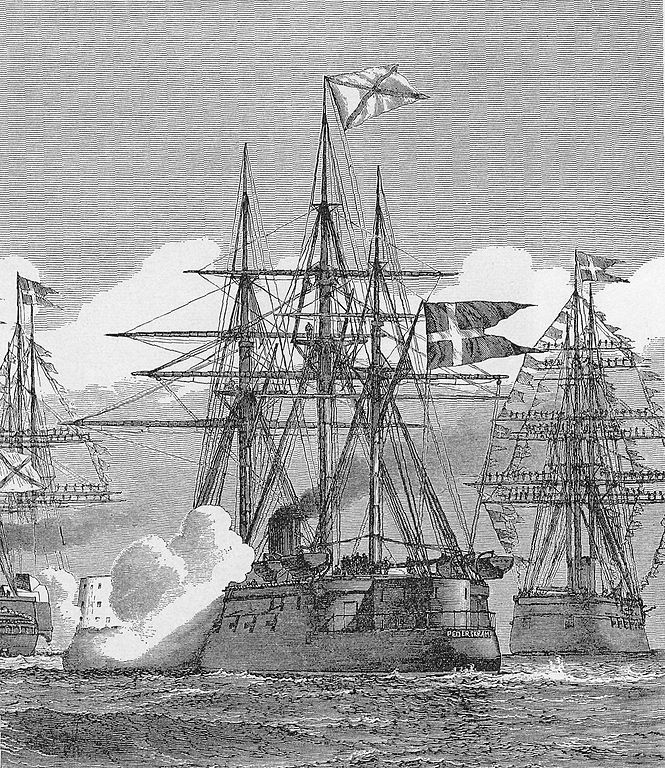
Peder Skram was delivered from Orlogsværftet in the summer of 1866. She made her first operational trip as an escort ship for the royal ship Schleswig with Princess Dagmar on board to her wedding in Saint Petersburg. In 1867, Peder Skram was refitted. In 1870 joined this year’s squadron manoeuvers for the first and only time. She stayed most of the time in reserve. She was refitted in 1876–78 with a new schooner rig, and more modern armament as described above.
As early as 1885, she was retired from the fleet, stricken on 7 December 1885. Her machinery and armor were removed to free her hull for other uses, she was hulked in other terms. Part of the armor was reused in Copenhagen’s fortifications. For a number of years she served as a reserve barracks ship, and converted later into an accommodation ship. When her general state was judged beyond recovery she was used as target ship for firing exercises. She was eventually sold for scrap in 1897.
She was commanded by Orlogskaptajn F. L. F. Sommer from 15. august 1866 to 20. oct. 1866 as well as in 1867 (reserve afterwards).
From 1. june 1870 to 15 september 1870 for this years exercises she was under command by J. S. C. Albeck.

Read More/Src
R. Steen Steensen, Vore panserskibe, (Marinehistorisk Selskab, 1968)
Conway’s all the world’s fighting ships 1860-1905
Links
http://www.navalhistory.dk/Danish/Skibene/P/PederSkram(1866).htm
https://da.wikipedia.org/wiki/Panserfregat_Peder_Skram
https://en.wikipedia.org/wiki/HDMS_Peder_Skram_(1864)

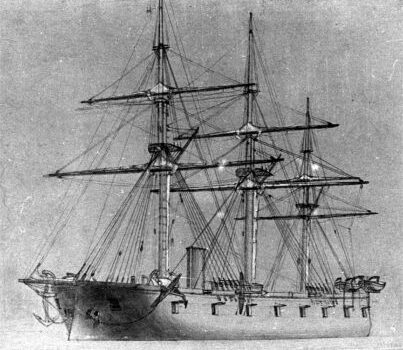

 Latest Facebook Entry -
Latest Facebook Entry -  X(Tweeter) Naval Encyclopedia's deck archive
X(Tweeter) Naval Encyclopedia's deck archive Instagram (@navalencyc)
Instagram (@navalencyc)





 French Navy
French Navy Royal Navy
Royal Navy Russian Navy
Russian Navy Armada Espanola
Armada Espanola Austrian Navy
Austrian Navy K.u.K. Kriegsmarine
K.u.K. Kriegsmarine Dansk Marine
Dansk Marine Nautiko Hellenon
Nautiko Hellenon Koninklije Marine 1870
Koninklije Marine 1870 Marinha do Brasil
Marinha do Brasil Osmanlı Donanması
Osmanlı Donanması Marina Do Peru
Marina Do Peru Marinha do Portugal
Marinha do Portugal Regia Marina 1870
Regia Marina 1870 Nihhon Kaigun 1870
Nihhon Kaigun 1870 Preußische Marine 1870
Preußische Marine 1870 Russkiy Flot 1870
Russkiy Flot 1870 Svenska marinen
Svenska marinen Søværnet
Søværnet Union Navy
Union Navy Confederate Navy
Confederate Navy Armada de Argentina
Armada de Argentina Imperial Chinese Navy
Imperial Chinese Navy Marinha do Portugal
Marinha do Portugal Mexico
Mexico Kaiserliche Marine
Kaiserliche Marine 1898 US Navy
1898 US Navy Sovietskiy Flot
Sovietskiy Flot Royal Canadian Navy
Royal Canadian Navy Royal Australian Navy
Royal Australian Navy RNZN Fleet
RNZN Fleet Chinese Navy 1937
Chinese Navy 1937 Kriegsmarine
Kriegsmarine Chilean Navy
Chilean Navy Danish Navy
Danish Navy Finnish Navy
Finnish Navy Hellenic Navy
Hellenic Navy Polish Navy
Polish Navy Romanian Navy
Romanian Navy Turkish Navy
Turkish Navy Royal Yugoslav Navy
Royal Yugoslav Navy Royal Thai Navy
Royal Thai Navy Minor Navies
Minor Navies Albania
Albania Austria
Austria Belgium
Belgium Columbia
Columbia Costa Rica
Costa Rica Cuba
Cuba Czechoslovakia
Czechoslovakia Dominican Republic
Dominican Republic Haiti
Haiti Hungary
Hungary Honduras
Honduras Estonia
Estonia Iceland
Iceland Eire
Eire Equador
Equador Iran
Iran Iraq
Iraq Latvia
Latvia Liberia
Liberia Lithuania
Lithuania Mandchukuo
Mandchukuo Morocco
Morocco Nicaragua
Nicaragua Persia
Persia San Salvador
San Salvador Sarawak
Sarawak Uruguay
Uruguay Venezuela
Venezuela Zanzibar
Zanzibar Warsaw Pact Navies
Warsaw Pact Navies Bulgaria
Bulgaria Hungary
Hungary

 Bundesmarine
Bundesmarine Dutch Navy
Dutch Navy Hellenic Navy
Hellenic Navy Marina Militare
Marina Militare Yugoslav Navy
Yugoslav Navy Chinese Navy
Chinese Navy Indian Navy
Indian Navy Indonesian Navy
Indonesian Navy JMSDF
JMSDF North Korean Navy
North Korean Navy Pakistani Navy
Pakistani Navy Philippines Navy
Philippines Navy ROKN
ROKN Rep. of Singapore Navy
Rep. of Singapore Navy Taiwanese Navy
Taiwanese Navy IDF Navy
IDF Navy Saudi Navy
Saudi Navy Royal New Zealand Navy
Royal New Zealand Navy Egyptian Navy
Egyptian Navy South African Navy
South African Navy






























 Ukrainian Navy
Ukrainian Navy dbodesign
dbodesign